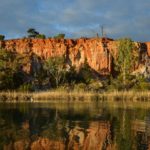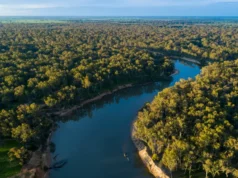The lightness of being at one with the landscape…
Wendy is taking team bonding to a new level. It’s 7am, we’re standing on a crumbling cliff face 40 metres above the Murray River, the wind is starting to sting, breakfast beckons below on the other side of the river, and she’s inexplicably bonded her backside to a small gap in the rock. She pushes and pulls but there’s no misinterpreting the holdup. Wendy is wedged.
Chuckles flow down the line like scroggin. So unlikely is her predicament that cameras are quickly (some would say cruelly) extracted from windcheaters. Breakfast can wait. It’s the high point of our four days together – both topographically and comically – and Wendy’s blushing cheeks complement the colour sunrise has already painted across our faces. With some effort and a round of applause she twists herself loose of the cliff’s clutches. Equilibrium restored she proceeds without further fuss to the bottom and inexorably towards breakfast.
We’re a tight team of nine by this second morning of the Murray River Walk, the newest of the Great Walks of Australia. It’s a four-day, three-night walk and boat cruise along the Murray River and its surrounding wetlands and floodplains, starting at the South Australian town of Renmark and heading upstream to the Victorian border, a total walking distance of 41 kilometres. Weary bodies are rewarded with accommodation and three-course dinners aboard a houseboat named Desire.
It’s the vision of Remark local Tony Sharley, who is also our head guide. Tony grew up with the Murray as his playground, fishing and camping on its banks. He had a moment of revelation as a teenager when a visitor started asking questions about the river and Tony realised he was almost completely ignorant about his own backyard. It ignited what would become his life’s work. He’s been an environmental scientist, worked in water policy and has now returned home to show people round and pass on his wealth of knowledge.
“This river is a metaphor for my life,” he says as we glide along in the small cruiser. “It’s been a journey.”
We cruise up the Murray from Renmark, diverting from the main stream to take a series of connector creeks and anabranches. Cormorants, egrets, pelicans and ducks set the sky alive as we weave between the red gums. With the walk only operating during the cooler months it’s no surprise we don’t see another boat on the river, nor another person for the entire trip.
A high river has greened the wetlands, but the welcome drink isn’t due to rain, it’s the result of careful planning and a series of weirs and environmental regulators that control the flow of water, implemented under the $13 billion dollar Murray Darling Basin Plan. Stewardship of the river is a major theme of the walk. We see evidence of vegetation recovery in the flood plains, with historically dry areas finally getting a much-needed soaking. It’s about replicating spring flooding in the wetlands by periodically inundating strategic areas of the flood plains.
We leave the narrow channel of the creek and reconnect with the Murray where we get a sense of awe that Charles Sturt must have felt in 1830 when he rowed his whale boat down the Murrumbidgee River and was abruptly shot out into what he would famously declare a “broad and noble river.” But it’s not long before we pull off the broad and noble and pull on our hiking boots.
For the next three days Tony and second guide Cassandra lead us through red gum forests, along creeks and natural animal pads, between salt bushes, grassy plains, old fence lines; leaving the river but always returning to it. Perhaps the most surprising thing is we never walk on a track. Not only that, there is no infrastructure for the walk at all. It’s not just minimal impact, it’s no impact; quite a remarkable achievement.
We gain an understanding and appreciation of the land that comes only come through unhurried passage. We stop and examine things as we pass, picking our way through the trackless land, improvising as we go. We spread out and strike up conversations with different people, who come from different backgrounds but are all united by this shared experience on the river. But it’s the steps leading to Wendy’s interment that will leave the most lasting impression.
The pre-dawn alarm would be cruel if it wasn’t for the promise of what lies ahead. We rug up and wordlessly climb into the cruiser in the pitch black, like prisoners executing a daring escape plan. Head-torches cast a tunnel of light through the mist and our exhaled breath. We slip away from Desire and her glowing orange warmth recedes until she becomes nothing more than dying embers of a far-away campfire. The cruiser shunts against the opposite bank and we pile out and scramble up a ridge leading to the top of Headings Cliff. In the space of 40 vertical metres we climb over the bottom of a 2.5 million year-old seabed, the floor of ancient Lake Bungunya and finally up honeycomb-textured sand blown in from the continental shelf during the last two ice ages. The morning call of a singing honeyeater chirps encouragement. On the cliff top we gather and wait for the sun to spill its warmth over the land, our faces and of course our constant companion, the broad and noble; gold-tipped, raked by the breeze, silent and shimmering in the sun.
The majority of the journey is more understated, but no less engrossing. We walk on oxbows and islands, which gives a remote feel. We never see another person or boat. Tony says walking on the banks gives a new perspective of the river. “To be on the bank looking at the water you can see how people lived and worked. You’re walking on a landscape a lot of people have made use of.”
We see countless red gums showing the unmistakable carved scars of aboriginal canoes and shields. We see middens, the remnants of old fireplaces, rocks finely shaped into cutting tools. We take off our boots and roll up pants to ford streams, pile into a strategically-stashed canoe for a more serious crossing, cross derelict sheep bridges.
We end every day the same way: aboard the grand houseboat Desire. Some sit on the edge of the boat and soothe tired feet in the Murray, others opt for the decadence of the top deck spa pool. Boat guide Mick serves a three-course meal of local delicacies every night from a menu put together by Adelaide chef Andrew Fielke. Post-dinner we reflect on the day, share battle stories, bird sightings, readings from the on-board library, and fine bottles of Riverland wine. We retire to comfortable bedrooms with floor to ceiling windows framing the river and the cliffs. An evening campfire on the final night is a fitting tribute to the history and the enduring spirit of the Murray.
Unlike the mighty river that runs through us, our journey eventually runs dry. Our presence is like the spring rains: ephemeral, but the experience is everlasting. When Desire carries us from the broad and noble for the last time there’s no sign of us or the remarkable Murray River Walk ever having been there. We leave no trace, but take away so much.



